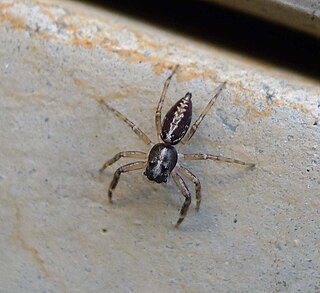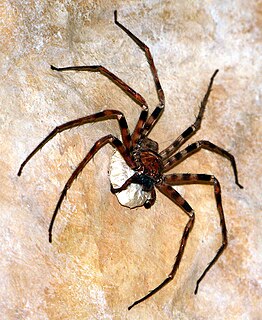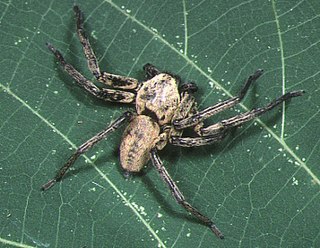
Myrmarachne is a genus of ant-mimicking jumping spiders that was first described by W. S. MacLeay in 1839. They are commonly called antmimicking spiders, but they are not the only spiders that have this attribute. The name is a combination of Ancient Greek μύρμηξ (myrmex), meaning "ant", and ἀράχνη (arachne), meaning "spider".

Gasteracantha is a genus of orb-weaver spiders first named by Carl Jakob Sundevall in 1833. The females of most species are brightly colored with six prominent spines on their broad, hardened, shell-like abdomens. The name Gasteracantha is derived from the Greek gaster (γαστήρ), meaning "belly, abdomen", and akantha (άκανθα), meaning "thorn, spine". Spiny-backed orb-weavers are sometimes colloquially called "crab spiders" because of their shape, but they are not closely related to the true crab spiders. Other colloquial names for certain species include thorn spider, star spider, kite spider, or jewel spider.

Canama is a genus of spiders in the jumping spider family, Salticidae. Its five described species occur from Borneo to Queensland.

Cosmophasis is a genus of spiders in the family Salticidae. Some species occur in Africa, while most are found in Southeast Asia, down to Australia. Although most species more or less mimic ants, there are also colorful species that follow a different strategy.

Cytaea is a genus of spiders in the family Salticidae.
Euryattus is a genus of spiders in the family Salticidae.
Omoedus is a genus of jumping spiders.
Pristobaeus is a genus of jumping spiders that was first described by Eugène Louis Simon in 1902.

Viciria is a genus of jumping spiders that was first described by Tamerlan Thorell in 1877. The genus includes thirty-one accepted species.

Zenodorus is a genus of the jumping spiders distributed from the Moluccas to Australia, including several islands of the Pacific. It was once considered a junior synonym of Omoedus, but this was later rejected by Jerzy Prószyński in 2017. At least one species, Z. orbiculatus, specializes on hunting ants.

Selenocosmia is a genus of tarantulas that was first described by Anton Ausserer in 1871.

Heteropoda is a genus of spiders in the family Sparassidae, the huntsman spiders. They are mainly distributed in tropical Asia and Australia, while at least one species, H. venatoria, has a cosmopolitan distribution, and H. variegata occurs in the Mediterranean.

Thelcticopis is a genus of huntsman spiders that occurs almost exclusively in the Australasian region, from India to Japan to New Guinea and Fiji. However, one species occurs in Costa Rica, and another in Congo basin, although the latter species is probably misplaced in this genus.

Euophryini is a tribe of jumping spiders. It has also been treated as the subfamily Euophryinae.

Oxyopes is a genus of lynx spiders found worldwide. It includes arounds 300 species and is classified under the lynx spider family Oxyopidae. Like other lynx spiders, they are easily recognizable by the six larger eyes arranged hexagonally on top of the head (prosoma), with the remaining smaller two eyes in front. They are also characterized by long spine-like bristles (setae) on their legs. They are ambush predators, actively hunting prey by sight. Though they produce and use silk, they do not build webs to capture prey.

Phlogiellus is a genus of tarantulas that was first described by Reginald Innes Pocock in 1897.
Parabathippus is a genus of Southeast Asian jumping spiders that was first described by J. X. Zhang & Wayne Paul Maddison in 2012.













